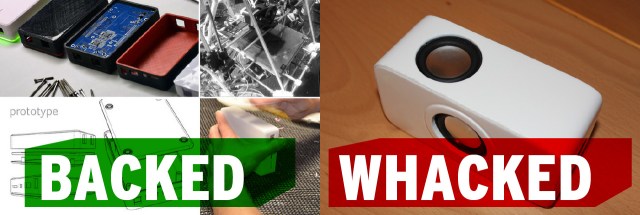Editor’s note: Ross Rubin is principal analyst at Reticle Research and writer for Engadget. His column examines crowdfunded products that have either met or missed their funding goals. Follow him on Twitter.
Designers of innovative high-tech products often face a dilemma between two of Kickstarter’s more popular categories. Should they mix in with the host of camera stabilizers, video dollies and iPhone acessories that populate the Product Design category? Or should they take their chances in the geekier, enthusiast project-driven Technology category? This week’s campaigns — launched on the same day — opted for the latter, but have achieved different levels of momentum.

Backed: AdTrap. The beneficent and upstanding job creators responsible for the various promotional quadrilaterals surrounding this column are among the finest people in the world. They seek only to alert you to their wonderful products and services so that they may enrich your life in ways delightful and rewarding; their missives demand only a pittance of some distraction and bandwidth consumption. And the memories of punching that monkey and Orbitz mini-golf will last a lifetime. Why one would ever want to use the Web or mobile devices without such enrichment is difficult to say.
Nonetheless, ne’er-do-well Chad Russell has won early support for his campaign using this one weird, old tip to eliminate online ads from the Web and app experience: AdTrap. The small white brick with Satanic green underlighting attaches to your home network and requires no configuration, as it serves all devices within the home and the dark lord. Alas, AdTrap won’t do anything to trap ads received over cellular connections, although a follow-on product might be an ad-blocking personal hotspot.
In a dark time before crowdfunding, known as 2005, a small device called Stingray was marketed at a similar price point. It was a zero-configuraton firewall that soon vanished from the market. But while firewall exceptions can be tricky to manage, it’s likely easier to manage ads on an all-or-nothing basis. Surely you, upstanding Web citizen, will do the right thing and choose all. But others are motoring AdTrap to a successful campaign, clearing 70 percent of the requested $150,000 with 22 days to go.
Whacked: Freakvibe. It may be a little early to call Freakvibe a failed campaign, but it has a long way to go toward its $90,000 Kickstarter goal. With only 10 percent down and 22 days to go, the company will only have a shot if it can pull out some strong late-inning support. The small brick-like speaker can, like countless other audio amplifiers, play music via an old-school, 30-pin dock connector or via Bluetooth. But what really sets the 2.1 system apart from most competitors is its ability to play music via near-field amplification. This means you can simply place any portable music-playing device atop the Freakvibe — even an old-school iPod nano — and it will amplify its audio output, even without any Bluetooth pairing.
Oh sure, you say, next I’ll be telling you that that there are invisible “radio waves” that we can use to send data anywhere and “gases” around us that we need to live. Yet, earlier this year, the accessory wizards over at ZAGG, Inc. turned their attention from Invisible Shields to invisible fields to offer the similar $39 iFrogz’ Boost, now being updated to the $59 Boost Plus. As is typical in Kickstarter, you’ll pay a premium for encouraging entrepreneurialism; $89 is the entry-level pledge to get your Freakvibe on and goes up from there to $149 for a version with Qi wireless charging, so you can charge your Nokia Lumia 920, Nexus 4 or Droid DNA. That’s a bit less to pay up than for PlayUp, JBL’s Nokia-inspired Qi-enabled Bluetooth boombox.
